|
Because of the cooler climate, which made growing the tropical plants they brought with them (taro, yam, kūmara, Polynesian tī, and the hue) difficult in many places and impossible in some, the early Polynesian settlers were faced with a real problem, as there was a dearth of native plants suitable for use as staple crops. The roots of the native species of tī (Cordyline), along with the root of the wild fern Pteridium esculentum (aruhe), were partial supplements, and the latter became increasingly important as the population increased, even in places where kūmara and taro grew comparatively well. However, the carefully prepared kernels of the karaka seem to have been equally important, their long-keeping qualities and ease of storage (as long as they were kept out of reach to rats) may have made them second only to kūmara in importance in many places until the introduction of the potato at the end of the eighteenth century. The appearance of the tree is quite reminiscent of the Planchonella species in the Islands, and even there cognate names in some places have been applied also to other species with large leaves and conspicuous, brightly coloured fruits.
Its importance is underlined by the widespread belief that the karaka was brought to Aotearoa from Hawaiki, "te karaka i ruia mai i runga i Rangiātea" (the karaka which was sown on Rangiātea, i.e. which came from the ceremonial centre of Eastern Polynesia at Ra'iatea, about 200 km northwest of Tahiti). However, the evidence is overwhelming that the tree was carried from the warmer Northern regions, probably -- but not certainly -- Taitokerau (Northland and Northern Auckland regions) to other parts of New Zealand, along with the Chatham, Kermadec and many other offshore islands, where it was planted in groves close to settlements. The one thing we know for sure, thanks to a genetic study by R.A. Atherton and colleagues in 2015, is that the trees on the Three Kings Islands (56 km from the northern tip of the Aupouri Peninsula) have been isolated for over a million years, so these at least got there by themselves without human intervention. There was nothing significant to indicate a point of origin or time of dispersal for trees growing in the Kermadecs and elsewhere in New Zealand. A follow-up study was completed to throw more light on where the karaka was first established and the timing of its dispersal to other parts of Aotearoa using different DNA markers. The results of this study have not yet been published, but Lara Shepherd, one of the researchers, informed me that this also reveals only part of the story. The Three Kings and Aupouri Peninsula are ruled out as the source of translocated populations. The Kermadec trees have similar DNA to plants found at several sites in Northland, in the Eastern Bay of Plenty, and Tauranga, so those are all possible sites of origin for the Kermadec trees, but we cannot yet be more specific than that. The plants in the Chathams have DNA found widely on the mainland, so a time of arrival and source of the original plants there, and indeed outside what appears to be their natural range on the mainland, cannot yet be determined.
The karaka is a striking canopy tree growing to about 15 metres high, with glossy green oval leaves 15 cm or more long. The species is endemic to Aotearoa. It flowers in the summer and the distinctive aroma of the ripening fruits is an evocative sign that autumn is at hand. The nectar seems to be potentially toxic to bees at a certain point in the season (or at least acts as a powerful narcotic on many of them), but any potential toxicity vanishes quickly even when those that return to the hive add it to the honey.
The ripe flesh of the berries is quite pleasant and safe to eat, but it was the highly toxic kernel containing the glycoside Karakin that was esteemed. The berries were prepared by boiling or steaming for a prolonged period and then soaking in running water, before being dried and roasted. The heat that would destroy the key toxins in the glycoside that, if present, would cause severe muscle contractions, powerful enough to rip the muscle from the bone and cause permanent deformities or death. There is some evidence that the toxicity of the uncooked fruit diminishes with age, but even 20-year old kernels have been found to have significant levels of toxicity (H.E. Connor, Poisonous Plants, p. 62). Furthermore the toxin's effects are cumulative, and it is only slowly eliminated from the body. Rats and pigs can tolerate the key toxic element (beta-Nitropropanoic Acid) fairly well, but people and dogs cannot. From one saying in the Mead and Grove collection, it would appear that before the detoxification was complete, the karakin may have been transformed into a halucinogen:
Ki te kainga weratia te karaka, ka roria.
Eating hot karaka berries will make you giddy. [M&G #1361]
Because of its resilience, borne out in our garden by the way the trees have recovered from repeated attacks from marauding wandering stock (cattle love to eat the leaves and young branches), the karaka was also a symbol of resilience and tenacity: "te pakari i te karaka", the sturdiness inherent in the karaka [M&G #40, #1546]. Its importance and the esteem in which it was held as a food is also underlined in this proverb:
Te anga karaka, te anga koura, koi kitea i te marae.
Karaka husks and crayfish shells should not be seen on the marae (i.e., don't give your visitors false expectations of a sumptuous feast in store.) [M&G # 2267
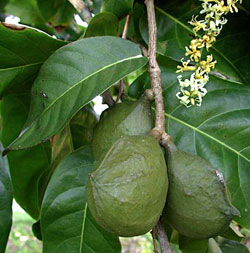 The Planchonella fruit were not eaten by people in Polynesia, but they did have a source of potentially edible and nutritious seeds that had to be detoxified by cooking. This was the ifi (ihi, i'i, ī, alternatively mape in Tahiti, the Tuamotus and Mangareva) or Polynesian "chestnut", Inocarpus fagifer, a tall (20-30 m high), slender tree which has many uses but is valued most of all for its seeds. The fruit was aptly described by Art Whistler as "rather like a large peanut growing on a tree" (Plants in Samoan Culture, p. 35). Like the peanut (Arachis hypogaea) the ifi is a member of the Fagaceae, the legume family; the cooked kernel of the New Zealand karaka berry is also often called the "Māori peanut". (The flowers, fruit and leaves of the ifi are illustrated on the left). The tree was carried by Polynesian navigators to every high island group in Polynesia except Hawai'i and Aotearoa. Experience with the Ifi would have provided a precedent for the early Polynesian arrivals in dealing with the Aotearoa version of the karaka. The fruit is the basis of an important food crop, especially when breadfruit are in short supply, but the seeds must be baked, roasted or boiled before they can be eaten. Unlike the karaka, the seeds of the tropical Polynesian tree deteriorate rapidly if removed from their protective casing, so the whole fruit is stored for a limited time when necessary, and either baked or roasted whole, or boiled. (Boiling is probably a modern innovation, as before the arrival of metal pots only peole living near thermal pools had a ready means of boiling water for long periods.) The Planchonella fruit were not eaten by people in Polynesia, but they did have a source of potentially edible and nutritious seeds that had to be detoxified by cooking. This was the ifi (ihi, i'i, ī, alternatively mape in Tahiti, the Tuamotus and Mangareva) or Polynesian "chestnut", Inocarpus fagifer, a tall (20-30 m high), slender tree which has many uses but is valued most of all for its seeds. The fruit was aptly described by Art Whistler as "rather like a large peanut growing on a tree" (Plants in Samoan Culture, p. 35). Like the peanut (Arachis hypogaea) the ifi is a member of the Fagaceae, the legume family; the cooked kernel of the New Zealand karaka berry is also often called the "Māori peanut". (The flowers, fruit and leaves of the ifi are illustrated on the left). The tree was carried by Polynesian navigators to every high island group in Polynesia except Hawai'i and Aotearoa. Experience with the Ifi would have provided a precedent for the early Polynesian arrivals in dealing with the Aotearoa version of the karaka. The fruit is the basis of an important food crop, especially when breadfruit are in short supply, but the seeds must be baked, roasted or boiled before they can be eaten. Unlike the karaka, the seeds of the tropical Polynesian tree deteriorate rapidly if removed from their protective casing, so the whole fruit is stored for a limited time when necessary, and either baked or roasted whole, or boiled. (Boiling is probably a modern innovation, as before the arrival of metal pots only peole living near thermal pools had a ready means of boiling water for long periods.)
The fruit of the karaka when steeped in water (and in some places the tree itself) was known as kōpī, possibly a word brought from Rarotonga (where it refers to some varieties of ginger), and the kernels of the nut when it had been prepared for eating were known as kōpīa. It is quite possible that the name kōpī was given to the whole tree by people aware that it was not, in fact, one of the Planchonellas.
 The significance of the karaka was underlined in 1960, when it replaced the traditional image of the sovereign on the one penny stamp. However efforts some years ago to work out a way of testing cooked karaka nuts to ensure that they were certifiably safe to eat (D.Klinac, R. Benton & S. Rentoul, Karaka Nuts: A "New" NZ Nut Crop, 2009) eventually failed because whatever method was used, it was possible only to prove that the level of toxic glycoside was significantly reduced, rather than completely eliminated. We could not prove conclusively what a safe level would be, because that would require the product to be tested on a large number of people, and given the known qualities of the toxin, approval for such tests was unlikely to be forthcoming. The significance of the karaka was underlined in 1960, when it replaced the traditional image of the sovereign on the one penny stamp. However efforts some years ago to work out a way of testing cooked karaka nuts to ensure that they were certifiably safe to eat (D.Klinac, R. Benton & S. Rentoul, Karaka Nuts: A "New" NZ Nut Crop, 2009) eventually failed because whatever method was used, it was possible only to prove that the level of toxic glycoside was significantly reduced, rather than completely eliminated. We could not prove conclusively what a safe level would be, because that would require the product to be tested on a large number of people, and given the known qualities of the toxin, approval for such tests was unlikely to be forthcoming.
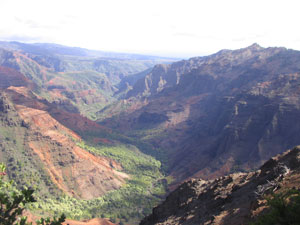 Outside Aotearoa, the largest concentration of translocated karaka is the island of Kauai in Hawai'i. The tree was first grown there in the 1890s, and the karaka had become naturalized in the Kōke'e district (inland on the north-west edge of the island) by 1912. Parts of the island were becoming eroded by deforestation for timber and the clearing of land for farming. The exotic "koa haole" or black wattle, Leucaena leucocephala (Fabaceae) was planted to provide cattle food, and the karaka was used extensively for reafforestation in the ensuing decades -- Elbert and Sckolmen (1989, p. 178) report that beween 1925 and 1927 the US Deprtment of Agriculture's Forest Service planted almost 5,000 trees on Kauai. In addition, a large airdrop of karaka seeds was made in the interior portion of the Waimea Canyon and adjacent areas in 1929. (The photograph shows part of the canyon near Kōke'e; it extends for 16 kilometres, partly through a massive rift caused by the collapse of part of the volcano that forms the core of the island. The canyon is a mile wide and over a thousand metres deep. The light-coloured trees on the canyon floor and parts of the canyon sides in the foreground are the iconic endemic Hawaiian koa (Acacia koa). The karaka were seeded further in. They have thrived, and are regarded as an invasive species threatening native flora, especially in parts of Kauai and Molokai. As in Aotearoa, the wild populations are thought to be plants growing from seeds distributed by birds. Outside Aotearoa, the largest concentration of translocated karaka is the island of Kauai in Hawai'i. The tree was first grown there in the 1890s, and the karaka had become naturalized in the Kōke'e district (inland on the north-west edge of the island) by 1912. Parts of the island were becoming eroded by deforestation for timber and the clearing of land for farming. The exotic "koa haole" or black wattle, Leucaena leucocephala (Fabaceae) was planted to provide cattle food, and the karaka was used extensively for reafforestation in the ensuing decades -- Elbert and Sckolmen (1989, p. 178) report that beween 1925 and 1927 the US Deprtment of Agriculture's Forest Service planted almost 5,000 trees on Kauai. In addition, a large airdrop of karaka seeds was made in the interior portion of the Waimea Canyon and adjacent areas in 1929. (The photograph shows part of the canyon near Kōke'e; it extends for 16 kilometres, partly through a massive rift caused by the collapse of part of the volcano that forms the core of the island. The canyon is a mile wide and over a thousand metres deep. The light-coloured trees on the canyon floor and parts of the canyon sides in the foreground are the iconic endemic Hawaiian koa (Acacia koa). The karaka were seeded further in. They have thrived, and are regarded as an invasive species threatening native flora, especially in parts of Kauai and Molokai. As in Aotearoa, the wild populations are thought to be plants growing from seeds distributed by birds.
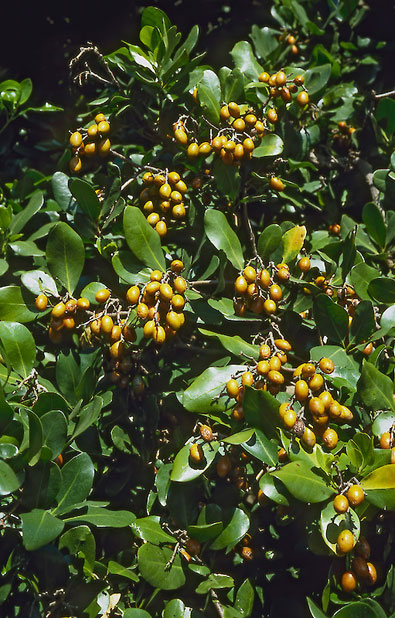
Corynocarpus laevigatus - Karaka
(Tree laden with ripe fruit,
Paraparaumu, Wellington. Photo (c) Jeremy Rolfe, NZPCN)
|
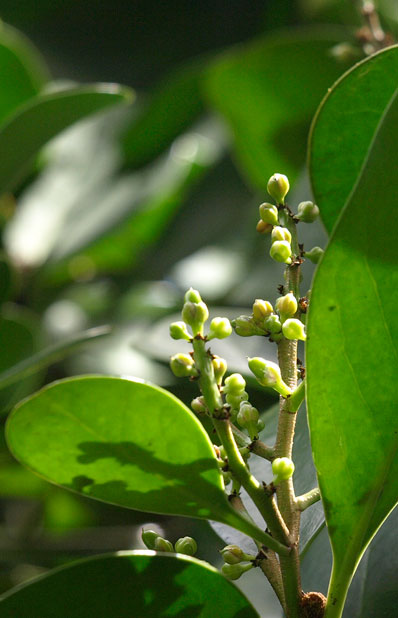
Corynocarpus laevigatus - Karaka
(Fruit beginning to form after flowering. Te Māra Reo. Photo: RB) |
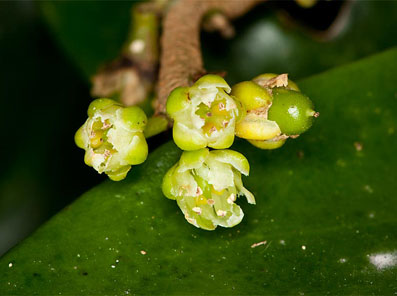
Corynocarpus laevigatus - Karaka
(Flowers and emerging fruit (detail). Photo: (c) Mike Theisen, NZPCN)
|
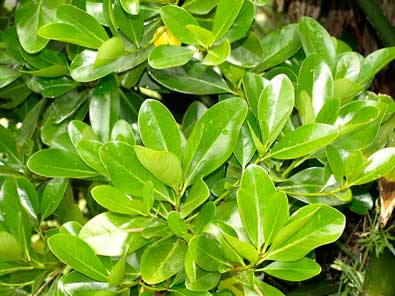
Corynocarpus laevigatus - Karaka
(Foliage; Photo: RB, Te Māra Reo.) |
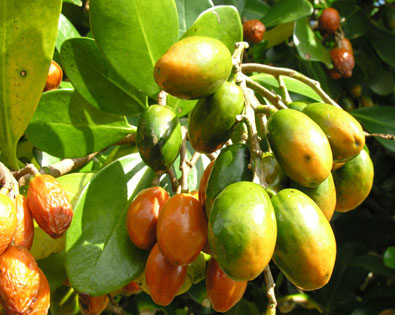
Corynocarpus laevigatus - Karaka
(Ripe fruit. Photo: (c) Simon Walls, NZPCN)
|
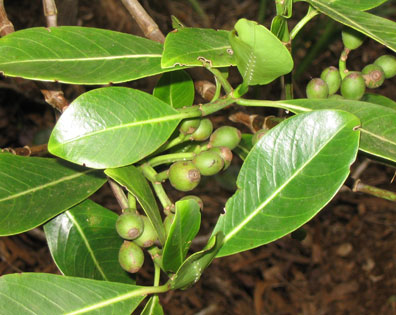
Planchonella sandwicensis - 'Ala'a (Fruit and foliage.)
(Kōke'e State Forest Park, Kauai, Hawaii. Photo: RB) |
|

